19 Feb, 2024 | Admin | No Comments
3 Key Read Aloud Strategies for Young Learners
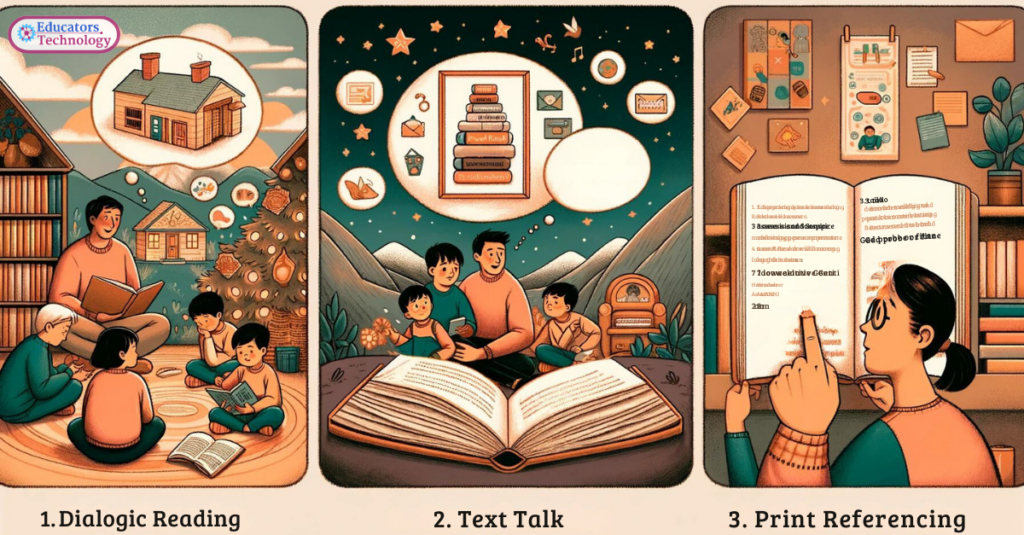
The art of reading aloud to children is a cherished tradition, known for its profound impact on language development, comprehension skills, and a lifelong love for literature. However, not all read-aloud practices harness the full potential of this interactive experience.
In the seminal paper by Lane and Wright (2007) titled “Maximizing the Effectiveness of Reading Aloud,” a comprehensive exploration into how read-aloud strategies can be optimized to support young readers is presented.
Drawing inspiration from their insightful research, this post delves into three pivotal read-aloud strategies: Dialogic Reading, Text Talk, and Print Referencing. Each method offers a unique approach to engaging children in the narrative, enhancing vocabulary, and fostering an early interest in the mechanics of reading.
By integrating these strategies into read-aloud sessions, educators and caregivers can transform passive listening into an active learning adventure, paving the way for children to become not just proficient readers, but passionate ones as well.
Related: 10 Research-Based Benefits of Reading Aloud to Children
Read Aloud Strategies
In their research paper “Maximizing the Effectiveness of Reading Aloud,” Lane and Wright discussed three key read-aloud methods: dialogic reading, text talk, and print referencing. The following is a quick review of each of these methods:
1. Dialogic Reading

Dialogic reading, a method developed by Whitehurst and colleagues (e.g., Arnold et al., 1994; Whitehurst et al., 1999) revolutionizes the traditional read-aloud experience by turning children from passive listeners into active participants in the storytelling process. This approach is built on three foundational principles: encouraging children to engage actively with the text, modeling more sophisticated language through feedback, and progressively challenging their understanding to enhance cognitive and linguistic skills.
Originally designed for preschoolers, dialogic reading, as Lane and Wright contend, is beneficial for older children as well, emphasizing interaction through specific prompts like “what” questions, open-ended inquiries, and prompts that connect the story to the child’s personal experiences. These strategies aim to deepen comprehension and foster a love for reading by making each book a dialogic journey that expands the child’s language and thinking skills.
By shifting the focus from merely reading to children to engaging them in a dialogue about the story, dialogic reading fosters an interactive environment where learning is enhanced. It also promotes active learning, language development, and critical thinking skills.
Dialogic reading encourages educators and parents to use a variety of prompts to elicit children’s responses, thereby personalizing the reading experience and making it more meaningful. As children become accustomed to this interactive style, they develop a deeper connection to reading, setting a foundation for lifelong learning and curiosity.
Example of Dialogic Reading
Imagine a preschool classroom where the teacher has chosen the book “The Very Hungry Caterpillar” by Eric Carle for a read-aloud session. Following the dialogic reading method, the teacher doesn’t simply read the book from beginning to end. Instead, she pauses at strategic points to engage the children with specific prompts. Examples of these prompts include:
- Completion Prompt: As the caterpillar eats through various foods, the teacher might say, “On Saturday, he ate through one piece of chocolate cake, one ice-cream cone, one pickle, one slice of Swiss cheese, one slice of salami, and one lollipop. Then he was…” and wait for the children to say “full” or “still hungry,” depending on what they recall.
- Recall Prompt: After reading about the caterpillar’s feast, the teacher might ask, “Can anyone remember what the caterpillar ate first?”
- Open-ended Prompt: Looking at the illustrations of the caterpillar transforming into a butterfly, the teacher might ask, “What do you think is happening to the caterpillar now?”
- Wh- Prompt: When the caterpillar builds a cocoon, the teacher could ask, “Why do you think the caterpillar wraps himself in a cocoon?”
- Distancing Prompt: Connecting the story to the children’s lives, the teacher might say, “Have you ever seen a caterpillar or a butterfly outside? What did it look like?”
Through these interactions, the children are not just passive listeners but active participants, using their own words to describe and engage with the story, thereby enhancing their comprehension and language skills.
2. Text Talk

Text Talk, developed by Beck, McKeown, and their team (e.g., Beck & McKeown, 2001; Beck et al., 2002) is a read-aloud strategy with a strong emphasis on enriching vocabulary among primary grade students. Unlike traditional read-aloud methods that may focus broadly on comprehension and enjoyment, Text Talk zeroes in on vocabulary development as its core objective.
Text Talk operates on the premise that in-depth discussions around the narrative and its language can serve as fertile ground for introducing and contextualizing new vocabulary. Teachers initiate this process by selecting a story, reading it aloud, and then engaging the students in a discussion that not only delves into the story’s content but also spotlights specific words for deeper exploration.
The strategic selection of these words is crucial; they should be relevant to the students’ experiences, definable in accessible language, and of practical utility in their linguistic repertoire. This approach not only aids in the acquisition of new vocabulary but also enhances students’ overall linguistic and cognitive development by making the learning process interactive and contextually grounded.
Related: 10 Great Reading Comprehension Games
Example of Text Talk
In a first-grade classroom, the teacher selects the book “Miss Rumphius” by Barbara Cooney for a text talk session, aiming to expand the students’ vocabulary.
- Pre-reading: The teacher introduces the book and tells the students that they will be learning some new words today. She highlights the words “lupines,” “conservatory,” and “wanderlust” as the focus for today’s lesson.
- During Reading: As the teacher reads the story, she pauses when she arrives at the targeted vocabulary words. For “lupines,” she stops and shows a picture of the flower, explains it grows in the wild, and can be many different colors. She connects “conservatory” to a greenhouse where plants are kept, using gestures and visuals to reinforce understanding. For “wanderlust,” she describes it as a strong desire to travel and see new places.
- Post-reading: After the story, the teacher engages the students in a discussion about Miss Rumphius’ adventures and how she spread lupine seeds everywhere she went. The teacher asks questions like, “Why do you think Miss Rumphius wanted to see new places? What does that tell us about her ‘wanderlust’?” and “Can you think of a place where you might find a conservatory or see lupines?”
By focusing on these words before, during, and after the reading, the teacher helps students deepen their understanding of new vocabulary in a meaningful context, encouraging them to use these words in their own sentences and discussions.
3. Print Referencing

Print referencing is a nuanced approach designed to enhance children’s awareness and understanding of written language during read-aloud sessions. Developed by Justice and Ezell (2004), this method incorporates both verbal and non-verbal cues to direct children’s attention to the text’s various elements, such as its form, features, and functions.
The essence of print referencing lies in increasing children’s metalinguistic focus, thereby fostering a deeper interest in print itself. As children begin to perceive written language as an entity worth exploring, they naturally develop a curiosity and appreciation for reading.
Print referencing strategy employs a mix of explicit and implicit cues woven seamlessly into the storytelling experience. These cues range from verbal interactions, like commenting on or asking questions about the text, to non-verbal actions, such as pointing to words or tracking the print with a finger as the story progresses.
The aim is to promote foundational literacy skills, including print concepts, word recognition, and alphabet knowledge. However, it’s important to balance the use of print referencing to avoid overwhelming young readers, ensuring that the primary joy of reading and narrative immersion isn’t lost.
Example of Print Referencing
Let’s create a scenario in a kindergarten classroom during a storybook reading session to illustrate the use of print-referencing cues based on Justice and Ezell’ s framework (2004, cited in Lane & Wright, 2007):
Title of the Book: “Goodnight Moon,” by Margaret Wise Brown and Clement Hurd
Verbal Cues:
- Question about Print: As the teacher opens “Goodnight Moon,” she displays the cover to the class and asks, “Can you find the title of this book?” This prompts the children to look at the print on the cover and recognize the concept of a title as the name of the book.
- Request about Print: Before starting the story, the teacher points to the top of a page and says, “Show me where I should start reading on this page.” This request helps children understand the organization of text on a page and reinforces the left-to-right direction of English reading.
- Comment about Print: During the reading, the teacher comes across a sign in the illustrations that says “STOP.” She points to it and remarks, “That word is ‘stop’.” This comment draws attention to specific print within the context of the story, helping children to make connections between written words and their meanings.
Nonverbal Cues:
- Pointing to Print: While reading a sentence about the children in the story finding a hidden path, the teacher points to the word “hidden” in the text. This action emphasizes the word and its role in the narrative, encouraging children to notice print and its meaning.
- Tracking Print: As the teacher reads aloud about the adventures in the magic garden, she consistently tracks her finger under the words. This continuous motion guides the children’s eyes across the page, demonstrating the flow of reading and reinforcing the concept of tracking print from left to right.
By incorporating these verbal and nonverbal print-referencing cues, the teacher not only enhances the children’s engagement with the story but also focuses their attention on the characteristics and functions of print. This method is instrumental in developing early literacy skills, such as print awareness, vocabulary, and the understanding of text conventions, setting a strong foundation for becoming proficient readers.
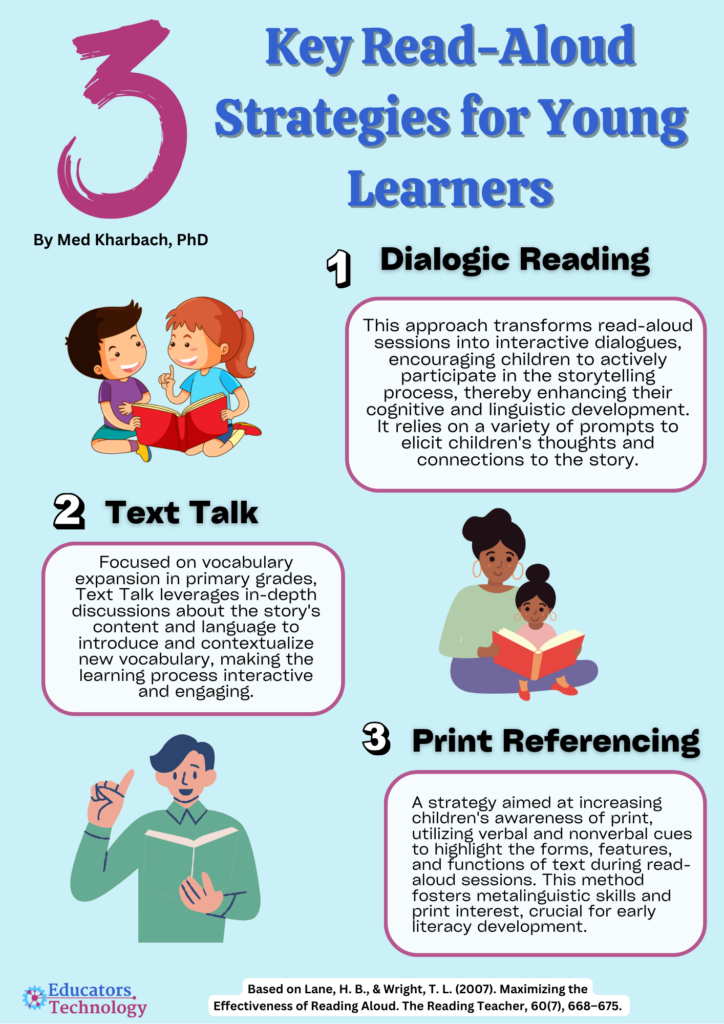
Concluding thoughts
The journey of reading with children is much more than sharing stories; it’s about actively engaging young minds in the rich tapestry of language and literacy. Drawing from the foundational work of Lane and Wright (20070, we’ve seen how Dialogic Reading, Text Talk, and Print Referencing each play a unique role in enhancing the read-aloud experience.
Incorporating these strategies into daily reading sessions can significantly impact children’s literacy development, setting them on a path of lifelong learning and curiosity. As educators, parents, and caregivers, our role is to nurture this journey, ensuring that each child feels the joy and power of language.
References
- Arnold, D. H., Lonigan, C.J., Whitehurst, G.J, & Epstein, J.N. (1994). Accelerating language development through picture book reading: Replication and extension to a videotape training format. Journal of Educational Psychology, 86, 235-243.
- Beck, J.L., & McKeown, M.G. (2001). Text talk: Capturing the benefits of read-aloud experiences for young children. The Reading Teacher, 55, 10-20.
- Justice, L.M., & Ezell, H.K. (2004). Print referencing: An emergent literacy enhancement strategy and its clinical applications. Language, Speech, and Hearing Services in Schools, 35, 185-193.
- Lane, H. B., & Wright, T. L. (2007). Maximizing the Effectiveness of Reading Aloud. The Reading Teacher, 60(7), 668–675. http://www.jstor.org/stable/20204520
- Whitehurst, G.J., Zevenbergen, A.A., Crone, D.A., Schultz, M.D., Velting, O.N., & Fischel, J.E. (1999). Outcomes of an emergent literacy intervention from Head Start through second grade. Journal of Educational Psychology, 91, 261-272.
The post 3 Key Read Aloud Strategies for Young Learners appeared first on Educators Technology.
29 Dec, 2023 | Admin | No Comments
Exploring Google’s Applied Digital Skills: A Treasure Trove for Educators and Students
I’m diving into something exciting today: Google’s Applied Digital Skills resource. If you’re always on the lookout for engaging, comprehensive lesson plans and digital tools, this one’s a game-changer. Let’s unpack what it offers and how it can transform our teaching and learning experiences.

A World of Lesson Plans at Your Fingertips
Under the “Teaching Resources” tab in Applied Digital Skills, there’s a wealth of lesson plans tailored to different educational levels – from late elementary to adult learners. What I appreciate is the ease of navigation. Just hit “Explore lessons,” and you’re off on a journey through an extensive collection.
And the search filters? They’re a lifesaver. Whether you’re looking for resources in digital tools like Google Docs, Sheets, or even more niche ones like AutoDraw and Jamboard, or specific topics ranging from Math to Digital Citizenship, these filters help you zero in on exactly what you need.
Related: Gemini – Google Groundbreaking AI Tool Explained for Teachers
Collections: Thematic Learning Journeys
The Collections feature is something I find particularly intriguing. It groups lessons around themes, allowing students to explore a subject like Math or Science through digital skills lenses. It’s a fantastic way to integrate technology into subject learning. Plus, there’s no strict sequence – students have the flexibility to tackle lessons in any order, which is great for differentiated learning.
In-Depth Lesson Details
Each lesson comes packed with detailed instructions, including estimated completion time, activities, required materials, and targeted skills. This level of detail is a godsend for busy educators. It’s like having a co-teacher who’s done half the work for you!
Rich Teaching Materials
Here’s the cherry on top: the teaching materials. Each lesson includes a comprehensive lesson plan with objectives, expected outcomes, and instructor guidance. Plus, printable certificates of completion and a sample rubric provide a tangible sense of achievement and a way to assess proficiency. And for those with spotty internet connections, the ability to download videos is a thoughtful touch.
Enhanced Features for Google Users
If you’re already using Google in your classroom, signing in with your Google credentials unlocks even more features. You can create classes, add lessons, track student progress, and see their work and video engagement. It’s like having a digital classroom assistant.
My Takeaway
As someone passionate about edtech, I find Google’s Applied Digital Skills to be a powerful resource. It not only offers diverse, ready-to-use content but also integrates digital tools seamlessly into the learning process. Whether you’re teaching elementary students or adult learners, there’s something here for everyone.
I’m particularly fond of how it encourages self-paced, thematic learning. In an era where personalized education is key, this resource is a step in the right direction. So, why not give it a try in your next lesson plan? Let’s embrace these tools to make learning more dynamic, relevant, and fun!
The post Exploring Google’s Applied Digital Skills: A Treasure Trove for Educators and Students appeared first on Educators Technology.
22 Dec, 2023 | Admin | No Comments
Best Lesson Plan Websites for Teachers
The internet is packed with innovative lesson planning resources to help you enhance your teaching strategies. I love digging into these resources and sharing with you my finds. In this post, I’m excited to share with you a curated selection of some of the best lesson plan websites available online.
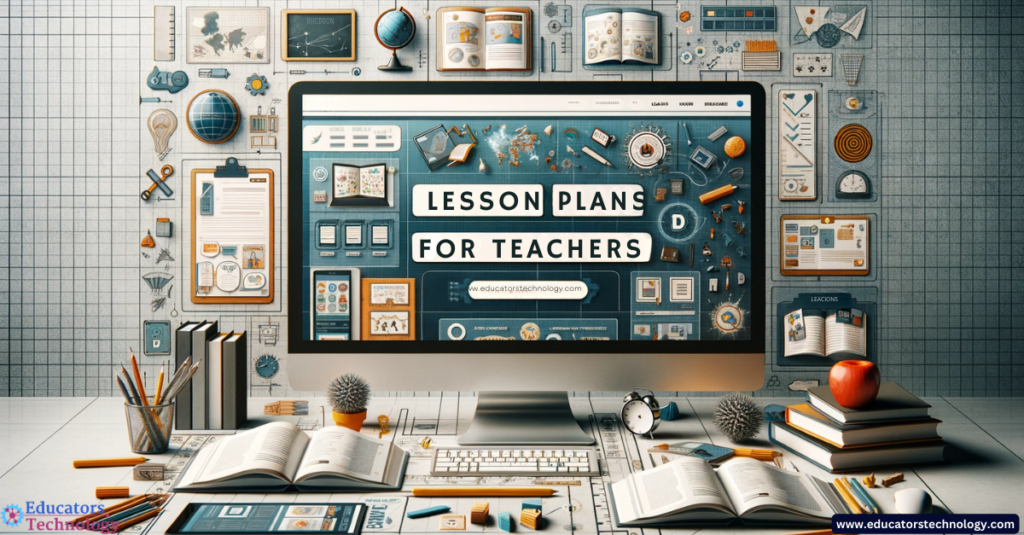
Each of these platforms brings something unique to the table, from comprehensive subject-specific resources to interactive multimedia content.These websites have been chosen for their quality, diversity, and user-friendliness, ensuring that you can find exactly what you need with minimal fuss.
Whether you’re looking for creative ways to teach math and science, engaging strategies for reading and writing, or innovative approaches to history and social studies, these sites have got you covered.
Lesson Plan Websites for Teachers
Here are our top picks for best lesson plan websites for teachers:
1. OER Commons
OER Commons is a remarkable hub among lesson plan websites, particularly for its expansive digital library and network. This platform is an excellent resource for educators seeking open education resources (OER), which are vital for innovative and flexible teaching methods. OER Commons offers a diverse array of materials across various subjects, including Mathematics, Life Science, and Social Science, making it an invaluable asset for teachers crafting comprehensive lesson plans for teachers.
2. PBS LearningMedia
PBS LearningMedia is another top good lesson plan website for teachers. It’s offers a multitude of free teaching resources, including videos, lesson plans, and interactive games. These resources are meticulously aligned with state and national standards, offering a reliable and high-quality educational experience. PBS LearningMedia’s strength lies in its ability to blend engaging content with educational standards, making it a go-to resource for teachers looking to enrich their lesson plans for teachers with multimedia elements and diverse learning tools.
3. ReadWorks
ReadWorks addresses a critical need in education: enhancing reading comprehension. As one of the more focused lesson plan websites, ReadWorks is dedicated to combating America’s reading comprehension crisis. This commitment is reflected in their provision of high-quality, research-based content, which is a boon for educators striving to improve reading skills among students. The platform’s user-friendly interface and rich resource pool make it an excellent choice for teachers who are focused on developing effective and engaging reading lesson plans for teachers.
4. ReadWriteThink
ReadWriteThink is another exemplary resource among lesson plan websites. It stands out for its comprehensive range of interactive tools and lesson plans specifically designed to foster reading and writing skills. What makes ReadWriteThink unique is its collaborative approach, involving educators in the development of its resources. This collaboration ensures that the lesson plans for teachers available on the site are not only pedagogically sound but also practically effective in the classroom.
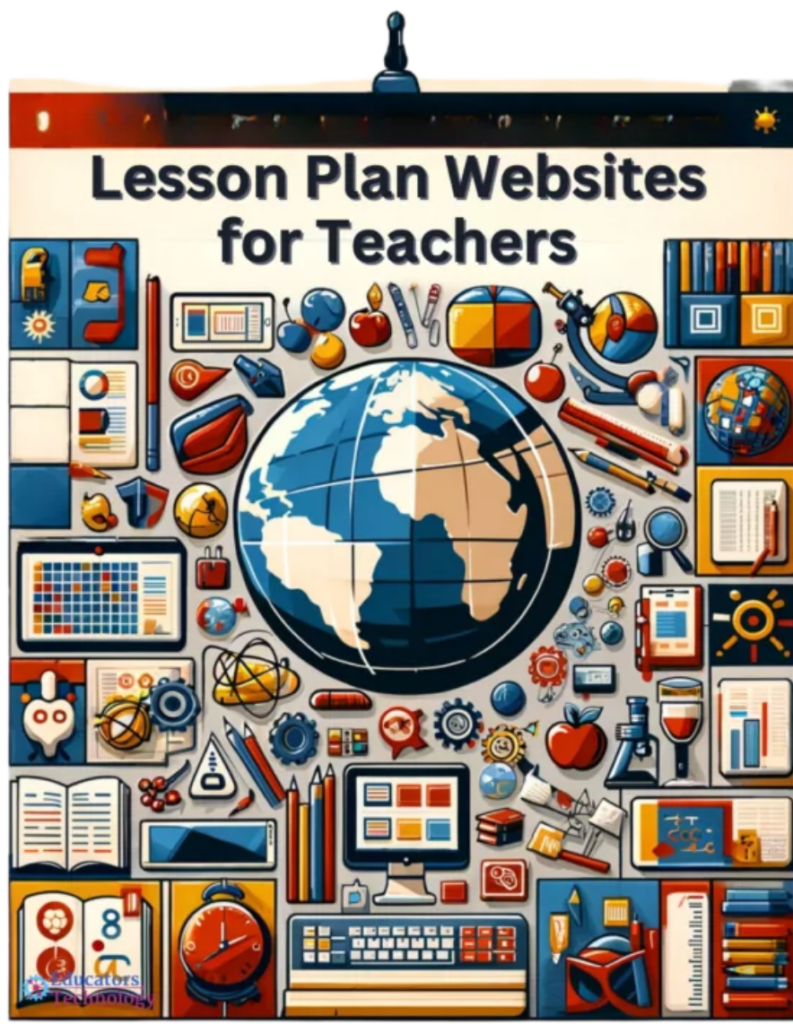
5. Lesson PlanetLesson PlansLesson Planet
Lesson Planet is a notable mention in the list of lesson plan websites, renowned for its extensive collection of teacher-reviewed resources. This platform is a treasure trove for educators seeking well-curated lesson plans for teachers, encompassing a wide range of subjects and educational levels. Lesson Planet offers resources that are not only diverse but also meticulously evaluated by educators, ensuring their applicability and quality. This makes it an invaluable tool for teachers who are constantly on the lookout for reliable and effective teaching materials to enrich their classroom experience.
6. Scholastic
Scholastic is a another good lesson plan website for teachers. Known for its vast array of educational resources, Scholastic provides teachers with innovative and engaging lesson plans. These resources span various subjects and age groups, making Scholastic a versatile and indispensable tool for educators. The strength of Scholastic lies in its ability to merge educational content with captivating storytelling, thereby enhancing the learning experience for students across different educational stages.
Related: Free Lesson Plan Templates
7. National Geographic Education
National Geographic Education, a junction where education meets exploration, transforms the learning experience with its immersive and interactive lesson plans, maps, and free resources. The strength of National Geographic Education lies in its commitment to providing endless learning opportunities through engaging, real-world contexts. This makes it an exceptional choice among lesson plan websites for teachers looking to bring the wonders of the world into their classrooms.
8. BrainPOP
BrainPOP stands out among lesson plan websites for its unique approach to education, offering a plethora of lesson plans crafted by the BrainPOP Educator community. This platform is not only resource-rich but also highly interactive, encouraging educators to contribute and customize lesson plans. BrainPOP’s strength lies in its diverse collection of topics and games, making it a go-to resource for teachers seeking innovative and engaging lesson plans for teachers, especially in interactive learning.
9. Annenberg Learner
Annenberg Learner offers a wealth of educational video programs with online and print materials for K-12 teachers’ professional development. Annenberg Learner distinguishes itself by not only targeting educators but also reaching students and lifelong learners, making its resources versatile and impactful. As a lesson plan website, it is invaluable for teachers seeking to enhance their pedagogical skills and classroom strategies.
10. Education World
Education World is another vital addition to the list of lesson plan websites. It serves as a comprehensive hub for educational resources, including a wide array of lesson plans for teachers. The site’s commitment to providing timely, relevant, and practical resources makes it a trusted ally for educators in their quest to deliver quality education. Education World is particularly appreciated for its blend of current educational news, practical advice, and high-quality teaching materials.
11. The Learning Network
The Learning Network by The New York Times offers an exceptional resource among lesson plan websites, especially for integrating current events into the classroom. This platform provides educators with resources that are not only informative but also engaging, utilizing the rich content of The New York Times. The Learning Network is ideal for teachers seeking to connect classroom learning with real-world events, offering lesson plans for teachers that are both relevant and thought-provoking.
Related: Canva Lessons – New Feature for Teachers
Final thoughts
In conclusion, the world of educational resources is vast and ever-expanding, and these lesson plan websites represent some of the best the internet has to offer for teachers. Each site we’ve explored brings its unique strengths to the table, whether it’s the comprehensive lesson plans of Lesson Planet, the engaging multimedia content of BrainPOP, or the real-world connections offered by National Geographic Education.
The post Best Lesson Plan Websites for Teachers appeared first on Educators Technology.
20 Dec, 2023 | Admin | No Comments
Chromebook Vs iPad Chart
The debate between choosing iPads and Chromebooks for classroom use is a topic of keen interest for educators, administrators, and parents alike. The decision to integrate either iPads or Chromebooks into educational settings is not just about choosing a piece of technology; it’s about selecting the right tool to enhance your teaching and optimize students learning.

Both iPads and Chromebooks bring their unique flavors to the classroom. iPads, known for their intuitive design and creative prowess, offer a gateway to a world of interactive and engaging learning experiences. On the other hand, Chromebooks, with their affordability and seamless integration with Google’s educational tools, present a practical, collaboration-centric approach.
Related: Best Tablets for Teachers
Chromebook Vs iPad
This comparison seeks to delve into the nuances of each, evaluating their strengths and limitations in the context of educational needs.
- User Interface and Apps: iPads have a very intuitive, user-friendly interface. This is a big plus for younger students or those not familiar with technology. The Apple App Store has a vast array of educational apps which are often well-designed and engaging. However, this variety can also be overwhelming, and not all apps are free.
- Creativity and Multimedia: iPads excel in creative tasks. They have superior multimedia capabilities – great cameras, audio, and video editing tools. This makes them ideal for projects that involve drawing, video creation, or music.
- Portability and Build: They are lightweight and have a solid build, which is a great advantage. However, the need for additional accessories like keyboards or Apple Pencils can add to the cost.
- Cost and Ecosystem Lock-in: iPads are generally more expensive. Also, they work best within the Apple ecosystem, which might require further investment in terms of apps and accessories.
- Affordability and Management: Chromebooks are typically more affordable. This is a key factor for schools operating on tight budgets. They are also easy to manage, especially with Google’s management tools, which is a big plus for IT departments in schools.
- Cloud-Based Learning and Collaboration: These devices are optimized for cloud-based learning. Google Classroom and other G Suite for Education tools work seamlessly on Chromebooks, fostering collaboration and ease of assignment submission.
- Keyboard and Web-Based Applications: Chromebooks come with a built-in keyboard, which is better for older students who need to type frequently. They rely heavily on web-based applications, which can be a limitation if high-end, specialized software is needed.
- Performance and Accessibility: The performance can vary depending on the model. While they are generally good for everyday tasks, intensive tasks might not run as smoothly. However, their compatibility with various educational software and accessibility features is commendable.
From my experience, the choice between an iPad and a Chromebook depends largely on the specific needs of your classroom or educational setting. iPads are great for enhancing creativity and multimedia engagement, while Chromebooks offer a more affordable, collaboration-focused experience.
It’s also about the ecosystem you’re already invested in or plan to invest in. If your school heavily uses Google’s educational tools, Chromebooks might be a more seamless fit. On the other hand, if you’re looking for a device that offers a range of creative applications and is intuitive for younger learners, iPads could be the way to go.
Chromebook Vs iPad Chart
Here is a quick chart comparing iPads and Chromebooks across various features, relevant to their use in education:
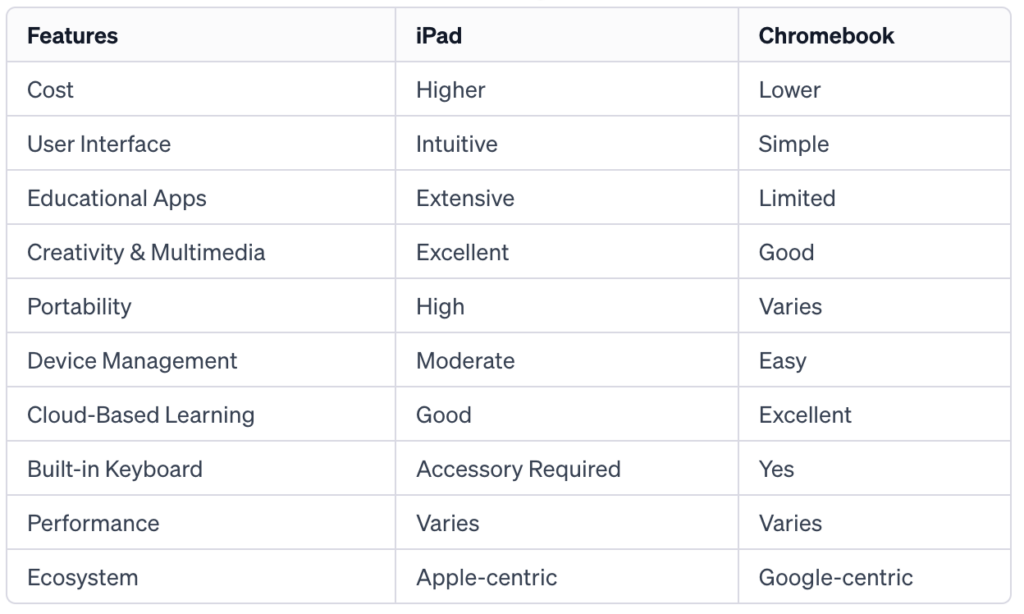
Final thoughts
In conclusion, the decision between iPads and Chromebooks in educational settings is not a one-size-fits-all solution. It’s a choice that hinges on a myriad of factors including budget constraints, educational objectives, the age of the students, and the existing technological infrastructure of the school or district.
Ultimately, the choice should be driven by the specific educational needs and goals of your institution. It might even be beneficial to have a blend of both, allowing for a more versatile and adaptable learning environment.
The post Chromebook Vs iPad Chart appeared first on Educators Technology.
20 Dec, 2023 | Admin | No Comments
6 Criteria for Website Evaluation
In a digitally saturated world where information a plentiful commodity, the ability to critically evaluate websites is more important than ever. While several sources offer a multitude of criteria for assessing the credibility and quality of online content, for the purpose of this discussion, we turn to the well-structured framework provided by Dalhousie University.
Dalhousie’s paper presents a clear and concise approach to website evaluation, focusing on six key aspects that are essential for determining the reliability and usefulness of a website. These criteria serve as a practical guide to navigate the digital realm, helping users to discern credible information in an age where data is abundant, but quality is not always guaranteed.
Criteria for Website Evaluation
By adopting Dalhousie University’s framework, we can effectively frame the six main criteria for website evaluation, providing a valuable toolset for anyone looking to critically analyze online content.
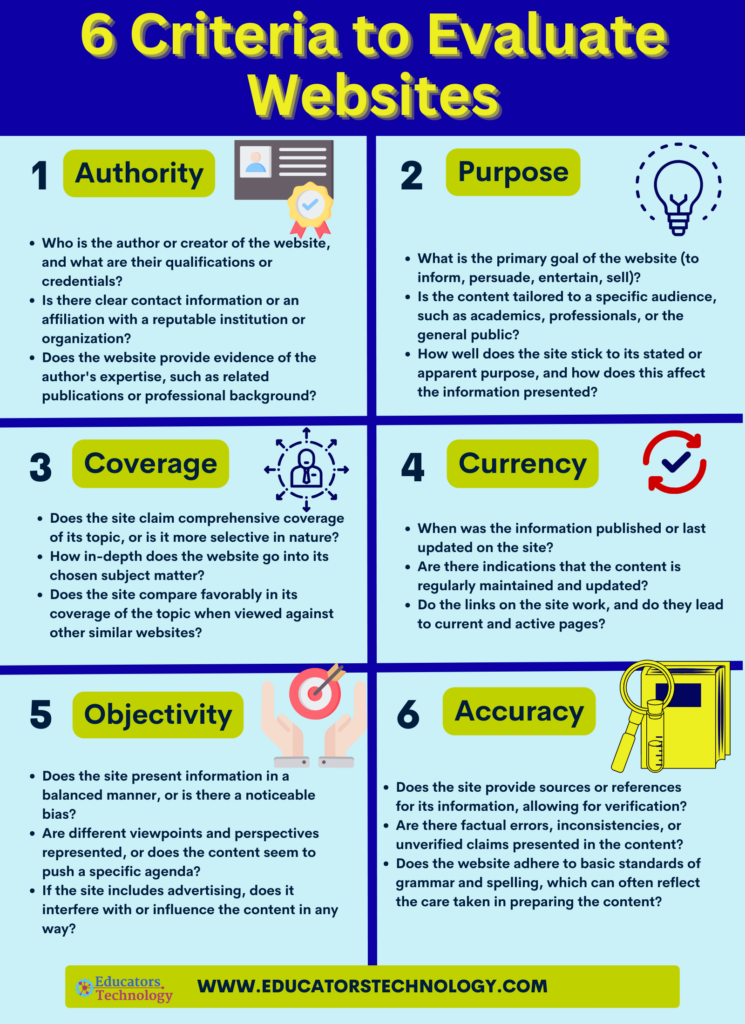
1. Authority
When evaluating a website’s authority, you’re essentially assessing the credibility of the source. It’s crucial to determine if the author or organization behind the site has the expertise and qualifications to provide reliable information. Consider the following questions:
- Who is the author or creator of the website, and what are their qualifications or credentials?
- Is there clear contact information or an affiliation with a reputable institution or organization?
- Does the website provide evidence of the author’s expertise, such as related publications or professional background?
2. Purpose
The purpose of a website dictates why the information is being presented and can influence its content and approach. Identifying the intent behind a website helps in understanding the angle or bias in the information presented. Ask yourself:
- What is the primary goal of the website (to inform, persuade, entertain, sell)?
- Is the content tailored to a specific audience, such as academics, professionals, or the general public?
- How well does the site stick to its stated or apparent purpose, and how does this affect the information presented?
3. Coverage
Coverage refers to the depth and breadth of the content provided by the website. It involves assessing how extensively the site explores its topics and whether the information is comprehensive or focuses on a specific aspect. Consider these questions:
- Does the site claim comprehensive coverage of its topic, or is it more selective in nature?
- How in-depth does the website go into its chosen subject matter?
- Does the site compare favorably in its coverage of the topic when viewed against other similar websites?
4. Currency
Currency in the context of a website refers to the timeliness and relevancy of the information it presents. In a rapidly changing world, having up-to-date information is crucial, especially in fields like technology, science, or current events. When evaluating currency, consider the following:
- When was the information published or last updated on the site?
- Are there indications that the content is regularly maintained and updated?
- Do the links on the site work, and do they lead to current and active pages?
5. Objectivity
Objectivity is about the impartiality and fairness of the content. Websites can sometimes present information with a certain bias or slant, which is essential to recognize for an accurate understanding. To gauge a website’s objectivity, ask:
- Does the site present information in a balanced manner, or is there a noticeable bias?
- Are different viewpoints and perspectives represented, or does the content seem to push a specific agenda?
- If the site includes advertising, does it interfere with or influence the content in any way?
6. Accuracy
Accuracy is crucial in establishing the trustworthiness of a website. It’s about the correctness of the information provided, including facts, details, and descriptions. When evaluating a website for accuracy, consider these questions:
- Does the site provide sources or references for its information, allowing for verification?
- Are there factual errors, inconsistencies, or unverified claims presented in the content?
- Does the website adhere to basic standards of grammar and spelling, which can often reflect the care taken in preparing the content?
- Is there a bibliography or a list of references that supports the content presented on the site?
Related: The 8 Elements of Critical Thinking
Final thoughts
As we encounter an overwhelming sea of information online, these criteria for websites evaluation serve as essential navigational tools, guiding us towards reliable and credible sources. By applying these standards – Authority, Purpose, Coverage, Currency, Objectivity, and Accuracy – we empower ourselves to make informed decisions, discern quality content, and avoid the pitfalls of misinformation.
Besides evaluation websites, this framework is also about fostering a critical mindset and a discerning eye in our digital interactions. Whether for academic research, personal knowledge, or professional purposes, these criteria ensure that our reliance on the internet is grounded in a foundation of critical thought and informed judgment.
The post 6 Criteria for Website Evaluation appeared first on Educators Technology.
18 Dec, 2023 | Admin | No Comments
The 7 Essential Elements of Digital Citizenship
In our increasingly digital world, the concept of digital citizenship has never been more important, especially for our students who are growing up in an online-centric era. Digital citizenship isn’t just about using technology; it’s about using it responsibly, ethically, and effectively. This encompasses a wide range of behaviors and skills, from protecting one’s personal information to engaging respectfully with others online.

As educators, it’s crucial that we equip our students with the knowledge and understanding to navigate the digital world safely and wisely. To aid in this endeavor, I’ve put together a comprehensive cheat sheet on digital citizenship. This resource breaks down the key elements of digital citizenship into easily digestible points, serving as a quick reference guide for students.
It’s designed to help them understand and internalize the principles of responsible digital behavior, ensuring they are prepared to make the most out of the digital world while staying safe and respectful.
The 8 Essential Elements of Digital Citizenship
Let’s explore some of the essential elements of digital citizenship:
1. Stay Safe Online
- Keep personal information private (e.g., address, phone number).
- Use strong, unique passwords for different accounts.
- Be cautious about clicking on unknown links or downloading files.
2. Respect Others
- Treat others as you would like to be treated.
- Avoid cyberbullying; report it if you see it.
- Respect the privacy and personal information of others.
3. Protect Your Digital Footprint
- Think before you post; your online actions can be permanent.
- Be mindful of the images and content you share.
- Manage your privacy settings on social media and online platforms.
4. Practice Ethical Behavior
- Respect copyright and intellectual property – don’t plagiarize or illegally download.
- Use technology and digital resources responsibly.
- Give credit to others for their work and ideas.
5. Balance Your Time
- Be aware of the amount of time spent online.
- Balance digital activities with offline experiences.
- Practice healthy habits, like taking breaks and being physically active.
6. Communicate Effectively
- Use clear and respectful language in digital communication.
- Understand the tone can be misinterpreted in texts and emails.
- Be considerate about what and when you share information.
7. Seek Help When Needed
- Ask for help if you’re unsure about something online.
- Report any inappropriate or harmful content or behavior.
- Talk to a trusted adult if you feel uncomfortable or threatened online.
Related: 3 Good Resources to Help Teachers Incorporate Digital Citizenship in Their Classroom Teaching
Final thoughts
In conclusion, understanding and practicing good digital citizenship is essential in today’s interconnected world. Our cheat sheet provides a straightforward, easy-to-understand framework for students to follow, encapsulating the core principles of safe, respectful, and responsible online behavior.
By incorporating these elements into their daily digital interactions, students can navigate the vast digital landscape more confidently and ethically. It’s important for us as educators and mentors to continually reinforce these principles, ensuring that our students not only become savvy digital users but also respectful and aware members of the online community.
Remember, digital citizenship skills are not just for the classroom; they are life skills that will help our students thrive in an increasingly digital future. Let’s commit to fostering these essential skills in our students, preparing them to be responsible, informed, and empathetic digital citizens.
The post The 7 Essential Elements of Digital Citizenship appeared first on Educators Technology.
16 Dec, 2023 | Admin | No Comments
Best iPad Apps for Teachers
As an educator and an edtech enthusiast with years of experience both in the classroom and in reviewing educational technology tools, I’ve always been passionate about finding tools that can transform our teaching and learning experiences.
Through my journey, both as a classroom teacher and an avid edtech blogger, I’ve had the opportunity to explore a multitude of apps. Each one offers unique features and capabilities, and I’ve seen firsthand how the right app can make a significant difference in engaging students, enhancing lessons, and streamlining educational processes.
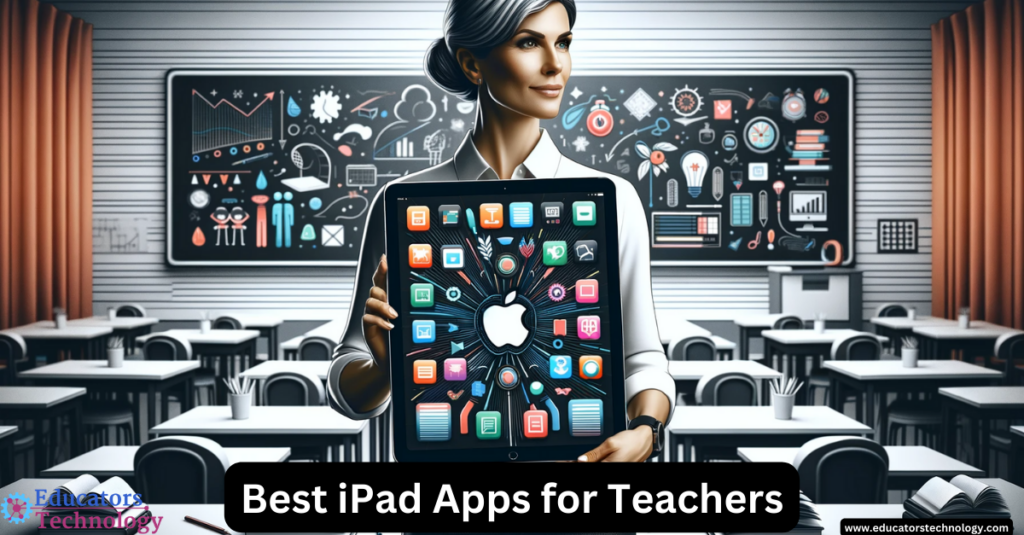
In this post, I’m excited to share with you a carefully curated list of the best iPad apps for teachers. This list is not just a compilation of popular choices, but a reflection of my personal experiences and extensive exploration in the field of educational technology.
From apps that transform your iPad into a powerful instructional tool to those that simplify classroom management and foster student creativity, each app on this list has been selected with the aim of helping you leverage technology to its fullest potential in your teaching journey.
So, whether you’re a seasoned educator or just starting to integrate technology into your classroom, I hope this list serves as a valuable resource in discovering the perfect blend of apps to enhance your teaching experience.
Best iPad Apps for Teachers
Let’s dive into some highly recommended apps that I’ve found to be exceptionally useful for teachers:
Google Classroom: This one is a game-changer for creating, distributing, and grading assignments in a paperless way. Its integration with other Google services makes it a versatile tool for managing classes.
Seesaw: Brilliant for student engagement! It’s an intuitive student-driven digital portfolio app that allows for creative expression through photos, videos, drawings, and text. A great way for students to showcase their learning.
Kahoot!: An absolute favorite for interactive learning. It turns quizzes and surveys into fun, game-like activities. It’s a fantastic way to review content and check for understanding in a lively manner.
Explain Everything: An interactive whiteboard app that’s perfect for creating instructional videos or presenting lessons. It’s like having a multimedia studio right in your iPad, enabling you to annotate, animate, narrate, and more.
Book Creator: This one is particularly close to my heart. It allows both teachers and students to create their own books. It’s a wonderful way to integrate creativity into lessons, and it works across subjects.
Related: Best Voice Over Presentation Apps
Notability: Ideal for note-taking and PDF annotation. It’s especially useful for organizing your teaching materials and scribbling down ideas on the go.
Flip: A unique video discussion platform. It empowers student voice and fosters a sense of community, allowing for shared video responses on topics or lessons.
Socrative: Great for real-time assessments. It helps gauge student understanding through quizzes, quick question polls, exit tickets, and space races.
Nearpod: This tool lets you create interactive lessons in minutes. It’s amazing for its range of activities like quizzes, open-ended questions, and virtual field trips.
Apple Pages: This is a powerful word processor that goes beyond mere document creation. It’s incredibly versatile for designing engaging worksheets, newsletters, and even books. The collaborative features are a bonus for group projects.
Kindle: An essential app for avid readers and educators. It provides access to a vast library of books, which can be an excellent resource for both personal and classroom use. The ability to highlight and make notes is particularly useful for teachers.
Trello: Fantastic for organization and project management. You can track assignments, plan lessons, and manage to-do lists, making it easier to stay on top of all your tasks.
Padlet: This app offers a virtual wall where students can collaborate, share ideas, and display their work. It’s very versatile and can be used for brainstorming, Q&A, or as a digital bulletin board.
Quizlet: Perfect for creating study sets, flashcards, and games. It’s a great tool for both learning and revision, making it easier for students to grasp and retain information.
Related: Best iPad Apps for Creating Interactive eBooks
Epic!: Dubbed as a ‘Netflix for kid’s books’, it provides access to thousands of high-quality children’s books, videos, and quizzes. It’s an excellent resource for encouraging reading in younger students.
Canva: A graphic design app that’s perfect for creating beautiful classroom materials, from presentations to posters. The user-friendly interface makes it accessible even to those who aren’t design-savvy.
Duolingo: If language learning is on your agenda, Duolingo offers a fun and interactive way to learn new languages. It’s great for both personal development and for integrating into language classes.
Pocket: This app is a ‘read it later’ service that allows you to save articles, videos, and stories from any publication, page, or app. Great for curating reading material for yourself or for classroom discussions.
TED: Offers access to thousands of educational videos from experts on various topics. These can be great conversation starters or supplementary material for a range of subjects.
Slack: Though not traditionally an educational app, Slack can be fantastic for teacher collaboration. It allows for organized communication, file sharing, and keeping everyone on the same page, especially in larger schools or departments.
Remind: A great communication platform that makes it easy to stay connected with students and parents. You can send reminders, assignments, and even conduct simple surveys.
Related: Best Writing Apps for iPad
ClassDojo: This app is wonderful for classroom management. It helps in tracking student behavior and achievements, and its interactive interface is engaging for younger students.
iMovie: A user-friendly video editing tool that’s great for creating class projects or instructional videos. It’s also fun for students to use for their own multimedia assignments.
GarageBand: For music teachers or any educator wanting to incorporate music into their lessons, GarageBand is a comprehensive app to create music or podcasts.
Dragon Anywhere: This is a powerful dictation app. It’s fantastic for teachers who prefer speaking over typing, allowing you to dictate notes, lesson plans, or even feedback on student work.
Evernote: A robust note-taking app that’s excellent for organizing all your teaching materials. You can clip web articles, capture handwritten notes, and attach PDFs or photos.
Green Screen by Do Ink: Allows you and your students to create green screen videos. It’s an engaging way to bring creativity into various subjects and presentations.
Photomath: Particularly useful for math teachers, this app solves math problems using your device’s camera. It’s a great way to check answers and understand step-by-step solutions.
Zoom: Essential for remote teaching and virtual classroom sessions. It’s also useful for hosting virtual parent-teacher conferences or staff meetings.
WeVideo: A fantastic video editing tool that’s cloud-based, making it accessible from anywhere. It’s great for creating and editing videos, perfect for class projects, digital storytelling, or even flipped classroom content.
Microsoft OneNote: An excellent note-taking app that’s also great for organizing lesson plans and student work. Its ability to sync across devices makes it a reliable tool for accessing your notes anytime, anywhere.
Google Keep: This app is a gem for quick note-taking, organizing to-dos, and capturing ideas on the fly. Its simple interface allows you to create color-coded notes and lists, and you can also add images and voice memos.
Related: Best Video Making Apps for iPad
Final thoughts
The apps I’ve shared in this list, curated from my extensive experience as an educator and edtech blogger, are more than just digital tools; they are gateways to innovative teaching and enriched learning. They represent the synergy between technology and education, each offering unique ways to engage, inspire, and organize.
As you explore these apps, I encourage you to approach them with an open mind and a creative spirit. Experiment with them, adapt them to your teaching style, and observe how they transform your classroom dynamics. The beauty of technology in education lies in its versatility and its ability to be molded to fit our diverse educational landscapes.
The post Best iPad Apps for Teachers appeared first on Educators Technology.
12 Dec, 2023 | Admin | No Comments
Physical Education Websites for Teachers and Students
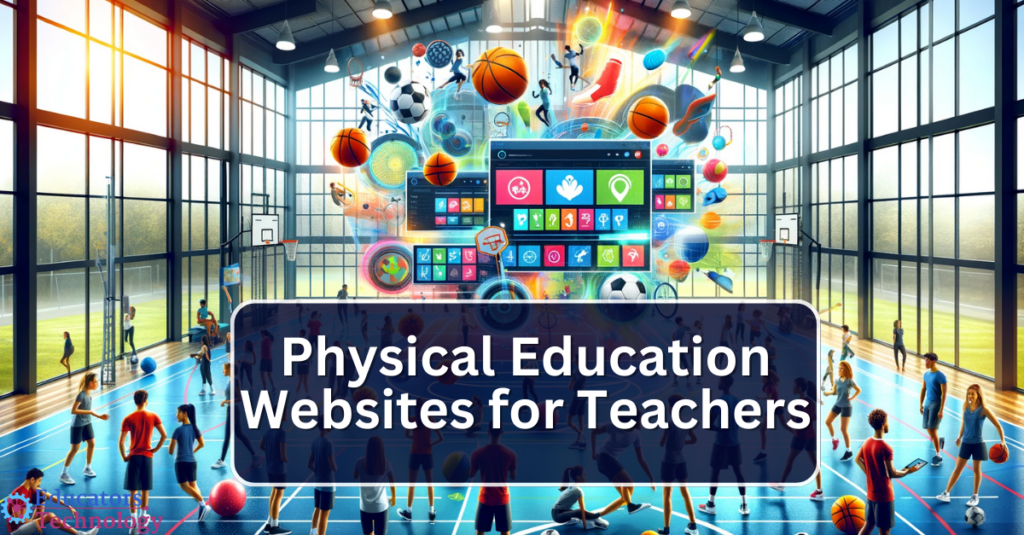
In the dynamic field of physical education, where fostering a lifelong commitment to health and wellness in students is key, having access to the right resources is crucial for educators. With the advancement of technology and educational strategies, physical education has evolved to encompass a broad spectrum of activities and teaching methodologies.
In this blog post, I share a selection of diverse and resourceful websites for physical education teachers. These platforms offer a treasure trove of tools, ideas, and insights, ranging from game-based learning and technology integration to comprehensive health education and professional development.
From the in-depth articles on PE Update to the tech-focused resources of The PE Geek, each website brings something unique to the table. Whether you’re looking to infuse new energy into your PE classes, stay abreast of the latest trends, or deepen your understanding of physical and health education, these resources are designed to support and inspire educators in creating engaging, effective, and inclusive PE programs.
Physical Education Websites for Teachers and Students
Here are some very good physical education websites for teachers and students:
1. PE Central
PE Central is a comprehensive resource for physical education teachers. It offers lesson plans, assessment ideas, and best practices for K-12 physical education classes. The site includes a wide range of activities, from traditional team sports to individual fitness challenges, catering to different age groups and skill levels. Additionally, PE Central provides resources for health education and ideas for integrating physical activity into other subject areas, making it a valuable tool for creating a holistic and inclusive PE curriculum.
2. ThePhysicalEducator.com
This website is an interactive resource for physical education teachers, featuring a variety of innovative teaching tools. It includes a blog with insightful articles, ready-to-use lesson plans, and a unique ‘Game Design Studio’ where teachers can create and share their own PE games. The site also offers infographics and visuals that can be used to enhance learning and engagement in PE classes. Its focus on professional development and community engagement makes it a great platform for educators looking to expand their PE teaching repertoire.
3. SHAPE America
SHAPE America (Society of Health and Physical Educators) is a leading national organization for health and physical education professionals. Their website provides a wealth of resources, including standards-based lesson plans, professional development opportunities, and advocacy tools. SHAPE America is known for its research-based practices and policy support, making it a go-to resource for teachers seeking to stay informed about the latest trends and best practices in physical education.
4. GoNoodle
GoNoodle offers a unique approach to physical education by providing short, interactive movement and mindfulness videos designed to energize and engage students. It’s particularly effective for incorporating physical activity into classroom settings, offering a fun and easy way for teachers to get students moving. GoNoodle’s videos cover a wide range of activities, from dancing to stretching, making it a versatile tool for promoting physical fitness and well-being in a variety of educational contexts.
5. Spark PE
Spark PE is dedicated to creating research-based physical education programs for children and adolescents. Their website offers curriculum materials, training programs, and assessment tools designed to foster lifelong wellness habits. The focus of Spark PE is on inclusive, active, and fun PE lessons that cater to a wide range of abilities and interests, ensuring that every student can participate and benefit from physical education. Their resources are particularly useful for teachers looking to implement evidence-based strategies and comprehensive PE programs in their schools.
6. PE Scholar
PE Scholar is a resource-rich platform for physical education professionals, offering a vast array of articles, research papers, teaching materials, and professional development guides. It serves as a great academic resource, providing in-depth insights into various aspects of physical education, from teaching strategies to the latest research in the field. The site is particularly useful for educators looking to deepen their understanding of PE theory and apply it in practical, innovative ways in their classrooms.
7. TeachPE
TeachPE is dedicated to providing free resources for both students and teachers of physical education, sports science, and health. It offers a wide range of content including lesson plans, training programs, and information on sports physiology and biomechanics. This makes it an ideal website for PE teachers seeking to expand their knowledge in sports science and integrate it into their teaching.
8. PhysEd Games
As the name suggests, PhysEd Games focuses on providing a vast collection of physical education games and activities. The website categorizes games by equipment, space, and age group, making it easy for teachers to find appropriate activities for their classes. It’s a great resource for those looking to diversify their PE activities and keep their classes dynamic and engaging.
9. Gopher PE Blog
The Gopher PE Blog is an extension of the Gopher Sport equipment store, offering an informative blog that covers a wide range of PE-related topics. Articles range from activity ideas and curriculum advice to tips on classroom management and student engagement. The blog is regularly updated with fresh content, making it a relevant and useful resource for modern PE educators looking to stay on top of current trends and ideas in physical education.
10. The PE Geek
Run by Jarrod Robinson, a leading expert in the field of technology in physical education, The PE Geek website focuses on integrating technology into PE teaching. It offers resources on using apps, gadgets, and tech tools to enhance physical education, making it ideal for educators looking to modernize their PE classes and engage digitally savvy students.
11. Cap’n Pete’s Power PE
A resource-rich website for physical education teachers, Cap’n Pete’s Power PE offers a variety of downloadable PE activities, games, and teaching resources. The site is known for its engaging and creative content, which includes holiday-themed activities, fitness challenges, and skill-based games, providing educators with innovative ideas to keep their PE classes exciting and inclusive.
12. PHE Canada (Physical and Health Education Canada)
PHE Canada is an excellent resource for Canadian PE teachers, but its wealth of information is valuable for educators worldwide. The site offers teaching tools, advocacy resources, and professional development opportunities. It’s particularly strong in promoting holistic health education, integrating physical, mental, and emotional well-being into physical education practices.
Final thoughts
In conclusion, the world of physical education is vast and continuously evolving, and the websites we’ve explored offer just a glimpse into the wealth of resources available to educators. These platforms collectively provide an array of materials and ideas that can transform the physical education experience for both teachers and students. From innovative game ideas on PhysEd Games to the comprehensive lesson plans on SHAPE America, each resource contributes to the goal of nurturing physically active, health-conscious, and well-rounded individuals. Embracing these tools and incorporating them into your teaching practice can lead to more dynamic, inclusive, and effective PE classes.
The post Physical Education Websites for Teachers and Students appeared first on Educators Technology.
The article lists the essential roles an efficient eLearning facilitator must adopt to benefit modern learners and enhance their experience.
This post was first published on eLearning Industry.
29 Sep, 2023 | Admin | No Comments
Upgrade Your Association’s Learning Management System For Member Engagement And Growth

Discover why upgrading your association’s LMS is essential, from boosting member engagement to seamless integration and accommodating growth.
This post was first published on eLearning Industry.
